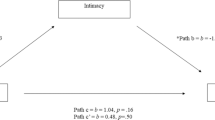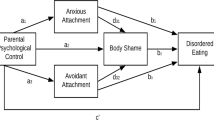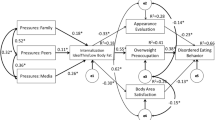Abstract
The Tripartite Influence Model (TIM) argues sociocultural agents affect body image dissatisfaction (BID) via the mediators of social comparison and internalization. BID subsequently influences disordered eating. Forty-seven Australian sister pairs (18–25 years) provided self-reports of perceived familial modeling and pressure by the sociocultural agents of mother, father and sister, social comparison, internalization, BID, bulimic behaviors, and dietary restriction. Sisters were correlated on internalization, BID, disordered eating, and parental modeling and pressure. Mothers and sisters were equally important modeling agents. Sisters were an equivalent social comparison target to peers. Consistent with the TIM, internalization and social comparison mediated familial pressure on BID. Contrary to the model, sister modeling directly affected bulimic behaviors and dietary restriction.

Similar content being viewed by others
References
Baron, R. M., & Kenny, D. A. (1986). The moderator–mediator variable distinction in social psychological research: Conceptual, strategic, and statistical considerations. Journal of Personality and Social Psychology, 51, 1173–1182.
Benedikt, R., Wertheim, E. H., & Love, A. (1998). Eating attitudes and weight-loss attempts in female adolescents and their mothers. Journal of Youth and Adolescence, 27, 43–56.
Bliss, N. D. (2000). The body image of closest-in-age adolescent sisters: The relative contribution of four theoretical explanations of body image disturbance. Unpublished honours thesis, Deakin University, Geelong, Victoria.
Bliss, N. D. (2005). Body image in adolescent girls: Evaluation of the Tripartite Influence Model. Unpublished Doctor of Psychology thesis, Deakin University, Geelong, Victoria.
Cafri, G., Yamamiya, Y., Brannick, M., & Thompson, J. K. (2005). The influence of sociocultural factors on body image: A meta-analysis. Clinical Psychology: Science and Practice, 12, 421–433.
Cattarin, J. A., Thompson, J. K., & Thomas, C. (2000). Body image, mood, and televised images of attractiveness: The role of social comparison. Journal of Social and Clinical Psychology, 19, 220–239.
de Leeuw, R. N. H., Snoek, H. M., van Leewe, J. F. J., van Strien, T., & Engels, R. C. M. E. (2007). Similarities and reciprocal influences in eating behavior within sibling pairs: A longituingal study. Eating Behaviors, 8, 464–473.
Dittmar, H., & Howard, S. (2004). Thin-ideal internalisation and social comparison tendency as moderators of media model’s impact on women’s body-focussed anxiety. Journal of Social and Clinical Psychology, 23, 768–791.
Dixon, R. S., Gill, J. M. W., & Adair, V. A. (2003). Exploring paternal influences on the dieting behaviours of adolescent girls. Eating Disorders, 11, 39–50.
Dunkley, T. L., Wertheim, E. H., & Paxton, S. J. (2001). Examination of a model of multiple sociocultural influences on adolescent girl’s dissatisfaction and dietary restraint. Adolescence, 36, 265–279.
Durkin, S. J., Paxton, S. J., & Sorbello, M. (2007). An integrative model of the impact of exposure to idealized female images on adolescent girls’ body satisfaction. Journal of Applied Social Psychology, 37, 1092–1117.
Faul, F., Erdfelder, E., Lang, A.-G., & Buchner, A. (2007). G*Power: A flexible statistical power analysis program for the social, behavioural, and biomedical sciences. Behavior Research Methods, 39, 175–191.
Garner, D. M. (1991). The eating disorder inventory-2: Professional manual. Odessa, FL: Psychological Assessment Resources.
Garner, D. M. (1997). The 1997 body image survey results. Psychology Today, 30, 30–47.
Groesz, L. M., Levine, M. P., & Murnen, S. K. (2002). The effect of experimental presentation of thin media images on body satisfaction: A meta-analytic review. International Journal of Eating Disorders, 31, 1–16.
Heinberg, L. J., & Thompson, J. K. (1995). Body image and televised images of thinness and attractiveness: A controlled laboratory investigation. Journal of Social and Clinical Psychology, 14, 325–338.
Howell, D. C. (2007). Statistical methods for psychology (4th ed.). Belmont, CA: Thompson Wadsworth.
Jones, D. C. (2001). Social comparison and body image: Attractiveness comparisons to models and peers among adolescent girls and boys. Sex Roles, 45, 645–664.
Jones, D. C. (2004). Body image among adolescent girls and boys: A longitudinal study. Developmental Psychology, 40, 823–835.
Keel, P. K., Heatherton, T. F., Harnden, J. L., & Hornig, C. D. (1997). Mothers, fathers, and daughters: Dieting and disordered eating. Eating Disorders, 5, 216–228.
Keery, H., van den Berg, P., & Thompson, J. K. (2004). An evaluation of the Tripartite Influence Model of body dissatisfaction and eating disturbance with adolescent girls. Body Image, 1, 237–251.
Kenardy, J., Brown, W. J., & Vogt, E. (2001). Dieting and health in young Australian women. European Eating Disorders Review, 9, 242–254.
Krones, P. G., Stice, E., Bates, C., & Kendra, O. (2005). In vivo social comparison to a thin-ideal peer promotes body dissatisfaction: A randomised experiment. International Journal of Eating Disorders, 38, 134–142.
Levine, M. P., Smolak, L., & Hayden, H. (1994). The relation of sociocultural factors to eating attitudes and behaviors among middle school girls. Journal of Early Adolescence, 14, 471–490.
Low, K. G., Charanasomboon, S., Brown, C., Hiltunen, G., Long, K., & Reinhalter, K. (2003). Internalization of the thin ideal, weight and body image concerns. Social Behavior and Personality, 31, 81–90.
Maude, D., Wertheim, E. H., Paxton, S., Gibbons, K., & Szmukler, G. (1993). Body dissatisfaction, weight loss behaviours, and bulimic tendencies in Australian adolescents with an estimate of female data representativeness. Australian Psychologist, 28, 128–132.
McCabe, M. P., & Ricciardelli, L. A. (2001). Parent, peer, and media influences on body image and strategies to both increase and decrease size among adolescent boys and girls. Adolescence, 36, 225–240.
McCabe, M. P., & Ricciardelli, L. A. (2005). A prospective study of pressures from parents, peers, and the media on extreme weight change behaviors among adolescent boys and girls. Behavior Research and Therapy, 43, 653–668.
McCabe, M. P., Ricciardelli, L. A., & Ridge, D. (2006). “Who thinks I need a perfect body?” Perceptions and internal dialogue among adolescents about their bodies. Sex Roles, 55, 409–419.
Moreno, A., & Thelen, M. H. (1993). Parental factors related to bulimia nervosa. Addictive Behaviors, 18, 681–689.
Nowak, M., Crawford, D., & Buttner, P. (2001). A cross-sectional study of weight and shape beliefs, behaviours and concerns of north Queensland adolescents. Australian Journal of Nutrition and Dietetics, 58, 174–180.
Pike, K. M., & Rodin, J. (1991). Mothers, daughters, and disordered eating. Journal of Abnormal Psychology, 100, 198–204.
Pruzinsky, T., & Cash, T. F. (2002). Understanding body images: Historical and contemporary perspectives. In T. F. Cash, & T. Pruzinsky (Eds.) Body image: A handbook of theory, research, and clinical practice (pp. 3–12). New York: The Guilford Press.
Ricciardelli, L. A., Tate, D., & Williams, R. J. (1997). Body dissatisfaction as a mediator of the relationship between dietary restraint and bulimic eating patterns. Appetite, 29, 43–54.
Rieves, L., & Cash, T. F. (1996). Social developmental factors and women’s body-image attitudes. Journal of Social Behavior and Personality, 11, 63–78.
Sanftner, J. L., Crowther, J. H., Crawford, P. A., & Watts, D. D. (1996). Maternal influences (or lack thereof) on daughters’ eating attitudes and behaviors. Eating Disorders, 4, 147–159.
Schutz, H. K., Paxton, S. J., & Wertheim, E. H. (2002). Investigation of body comparison among adolescent girls. Journal of Applied Social Psychology, 32, 1906–1937.
Shoemaker, C., van Strien, T., & van ser Staak, C. (1994). Validation of the eating disorders inventory in a nonclinical population using transformed and untransformed responses. International Journal of Eating Disorders, 15, 387–393.
Shroff, H., & Thompson, J. K. (2006). The tripartite influence model of body image and eating disturbance: A replication with adolescent girls. Body Image, 3, 17–23.
Stice, E. (1994). Review of the evidence for a sociocultural model of bulimia nervosa and an exploration of the mechanisms of action. Clinical Psychological Review, 14, 633–661.
Stice, E. (1998). Modeling of eating pathology and social reinforcement of the thin-ideal predict the onset of bulimic symptoms. Behavior Research and Therapy, 36, 931–944.
Stice, E., & Agras, W. S. (1998). Predicting onset and cessation of bulimic behaviors during adolescence: A longitudinal grouping analysis. Behavior Therapy, 29, 257–276.
Stice, E., Chase, A., Stormer, S., & Appel, A. (2001). A randomised trial of a dissonance-based eating disorder prevention program. International Journal of Eating Disorders, 29, 247–262.
Stice, E., Killen, J. D., Hayward, C., & Taylor, C. B. (1998). Age of onset for binge eating and purging during late adolescence: A 4-year survival analysis. Journal of Abnormal Psychology, 107, 671–675.
Stice, E., Mazotti, L., Krebs, M., & Martin, S. (1998). Predictors of adolescent dieting behaviors: A longitudinal study. Psychology of Addictive Behaviors, 12, 195–205.
Stice, E., Mazotti, L., Weibel, D., & Agras, S. W. (2000). Dissonance prevention program decreases thin-ideal internalisation, body dissatisfaction, dieting, negative affect, and bulimic symptoms: A preliminary experiment. International Journal of Eating Disorders, 27, 206–217.
Stice, E., & Shaw, H. (2002). Role of body dissatisfaction in the onset and maintenance of eating pathology: A synthesis of research findings. Journal of Psychosomatic Research, 53, 985–993.
Stice, E., & Tristan, J. (2005). Sociocultural pressures and body image disturbance: A comment on Cafri, Yamamiya, Brannick, and Thompson. Clinical Psychology: Science and Practice, 12, 443–446.
Stice, E., & Whitenton, K. (2002). Risk factors for body image in adolescent girls: A longitudinal investigation. Developmental Psychology, 38, 669–678.
Stormer, S. M., & Thompson, J. K. (1996). Explanations of body image disturbance: A test of maturational status, negative verbal commentary, social comparison, and sociocultural factors. International Journal of Eating Disorders, 19, 193–202.
Thelen, M. H., & Cormier, J. F. (1995). Desire to be thinner and weight control among children and their parents. Behavior Therapy, 26, 85–99.
Thompson, J. K., Coovert, M. D., & Stormer, S. M. (1999a). Body image, social comparison, and eating disturbance: A covariance structure modeling investigation. International Journal of Eating Disorders, 26, 43–51.
Thompson, J. K., Heinberg, L. J., Altabe, M., & Tantleff-Dunn, S. (1999b). Exacting beauty: Theory, assessment, and treatment of body image disturbance. Washington, DC: American Psychological Association.
Thompson, J. K., & Stice, E. (2001). Thin-ideal internalization: Mounting evidence for a new risk factor for body-image disturbance and eating pathology. Current Directions in Psychological Science, 10, 181–183.
Thompson, J. K., van den Berg, P., Roehig, M., Guarda, A. S., & Heinberg, L. J. (2004). The sociocultural attitudes towards appearance scale-3 (SATAQ-3): Development and validation. International Journal of Eating Disorders, 35, 293–304.
Tiggemann, M. (2006). The role of media exposure in adolescent girls’ body dissatisfaction and drive for thinness: Prospective results. Journal of Social and Clinical Psychology, 25, 523–541.
Tiggemann, M., & McGill, B. (2004). The role of social comparison in the effect of magazine advertisements on women’s mood and body dissatisfaction. Journal of Social and Clinical Psychology, 23, 23–44.
Tiggemann, M., & Slater, A. (2004). Thin ideals in music television: A source of social comparison and body dissatisfaction. International Journal of Eating Disorders, 35, 48–58.
Tsiantas, G., & King, R. M. (2001). Similarities in body image in sisters: The role of sociocultural internalisation and social comparison. Eating Disorders, 9, 141–158.
van den Berg, P., Thompson, J. K., Obremski-Brandon, K., & Coovert, M. (2002). The Tripartite Influence Model of body image and eating disturbance: A covariance structure modeling investigation testing the mediational role of appearance comparison. Journal of Psychosomatic Research, 53, 1007–1020.
Vincent, M. A., & McCabe, M. P. (2000). Gender differences among adolescents in family, and peer influences on body dissatisfaction, weight loss, and binge eating behaviours. Journal of Youth and Adolescence, 29, 205–221.
Vitousek, K. B., Daly, J., & Heiser, C. (1991). Reconstructing the internal world of the eating-disordered individual: Overcoming denial and distortion in self-report. International Journal of Eating Disorders, 10, 647–666.
Wertheim, E. H., Martin, G., Prior, M., Sanson, A., & Smart, D. (2002). Parent influences in the transmission of eating and weight related values and behaviors. Eating Disorders, 10, 321–334.
Wertheim, E. H., Paxton, S. J., & Blaney, S. (2004). Risk factors for the development of body image disturbances. In J. K. Thompson (Ed.) Handbook of eating disorders and obesity (pp. 463–494). Hoboken, New Jersey: John Wiley & Sons.
Wertheim, E. H., Paxton, S. J., Schutz, H. K., & Muir, S. L. (1997). Why do adolescent girls watch their weight? An interview study examining sociocultural pressures to be thin. Journal of Psychosomatic Research, 42, 345–355.
Wood, J. (1989). Theory and research contributing social comparisons of personal attributes. Psychological Bulletin, 106, 231–248.
Author information
Authors and Affiliations
Corresponding author
Rights and permissions
About this article
Cite this article
Coomber, K., King, R.M. The Role of Sisters in Body Image Dissatisfaction and Disordered Eating. Sex Roles 59, 81–93 (2008). https://doi.org/10.1007/s11199-008-9413-7
Received:
Accepted:
Published:
Issue Date:
DOI: https://doi.org/10.1007/s11199-008-9413-7




